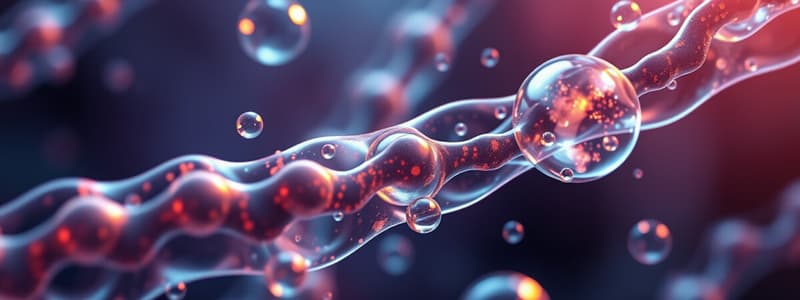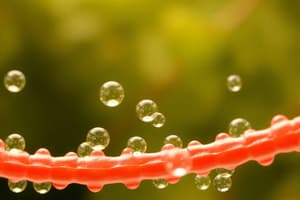Podcast
Questions and Answers
What role do integral proteins NOT perform in the cellular context described?
What role do integral proteins NOT perform in the cellular context described?
- Recapturing neurotransmitters (correct)
- Serving as cell identity markers
- Acting as channels or carriers
- Providing skeletal framework and adhesion
Which statement about glycocalyx is inaccurate?
Which statement about glycocalyx is inaccurate?
- It surrounds the entire outer surface of the cell.
- It is composed primarily of nucleic acids. (correct)
- Its presence contributes to a negative surface charge on cells.
- It includes both glycoproteins and glycolipids.
Which of the following is a function of proteoglycans?
Which of the following is a function of proteoglycans?
- Acting as hormones
- Providing structural support through carbohydrate-rich environments (correct)
- Regulating cell permeability
- Binding to larger protein structures
What characteristic is associated with the surface charge of most cells due to glycocalyx?
What characteristic is associated with the surface charge of most cells due to glycocalyx?
Which of the following statements regarding the endoplasmic reticulum is correct based on the provided information?
Which of the following statements regarding the endoplasmic reticulum is correct based on the provided information?
Which lipids are primarily involved in preferential diffusion of substances across the cell membrane?
Which lipids are primarily involved in preferential diffusion of substances across the cell membrane?
What type of proteins are attached only to one surface of the membrane and do not traverse it?
What type of proteins are attached only to one surface of the membrane and do not traverse it?
Which of the following substances can most likely cross the cell membrane directly by dissolving in the lipid bilayer?
Which of the following substances can most likely cross the cell membrane directly by dissolving in the lipid bilayer?
What describes the nature of water-soluble particles in terms of crossing the cell membrane?
What describes the nature of water-soluble particles in terms of crossing the cell membrane?
What is a critical characteristic of lipid-soluble particles in the context of membrane transport?
What is a critical characteristic of lipid-soluble particles in the context of membrane transport?
How do water-soluble substances typically transport across the cell membrane?
How do water-soluble substances typically transport across the cell membrane?
What do the hydrophobic regions of phospholipids primarily serve to do?
What do the hydrophobic regions of phospholipids primarily serve to do?
What role do integral proteins play in relation to the cell membrane?
What role do integral proteins play in relation to the cell membrane?
Which of the following functions do not occur within cells that utilize large amounts of energy?
Which of the following functions do not occur within cells that utilize large amounts of energy?
Which enzyme is NOT involved in the intracellular digestive system of high-energy cells like cardiomyocytes?
Which enzyme is NOT involved in the intracellular digestive system of high-energy cells like cardiomyocytes?
What primary substance is NOT a typical energy source for cells based on their chemical reactions with oxygen?
What primary substance is NOT a typical energy source for cells based on their chemical reactions with oxygen?
Which type of cell is characterized by having far more mitochondria compared to fat cells?
Which type of cell is characterized by having far more mitochondria compared to fat cells?
What is the fate of fats when processed by cells that extract energy?
What is the fate of fats when processed by cells that extract energy?
Which type of protein is primarily involved in the structural framework of organelles through microtubule formation?
Which type of protein is primarily involved in the structural framework of organelles through microtubule formation?
What is recognized as the powerhouse of the cell responsible for energy production?
What is recognized as the powerhouse of the cell responsible for energy production?
Which cellular structure is primarily responsible for regulating cellular transport and maintaining the internal environment?
Which cellular structure is primarily responsible for regulating cellular transport and maintaining the internal environment?
Which of the following macromolecules is considered the major nutritional source for cells?
Which of the following macromolecules is considered the major nutritional source for cells?
What component predominantly dictates the permeability of the lipid bilayer to water-soluble substances?
What component predominantly dictates the permeability of the lipid bilayer to water-soluble substances?
What is the primary role of secretory vesicles in the cell?
What is the primary role of secretory vesicles in the cell?
What distinguishes mitochondria from other organelles in terms of DNA?
What distinguishes mitochondria from other organelles in terms of DNA?
How do lysosomes contribute to cellular functions?
How do lysosomes contribute to cellular functions?
What is the significance of the number of mitochondria in a cell?
What is the significance of the number of mitochondria in a cell?
What is the main function of the detoxifying substances produced by cellular processes?
What is the main function of the detoxifying substances produced by cellular processes?
What role do mitochondria play in cellular metabolism?
What role do mitochondria play in cellular metabolism?
Which cellular organelle is primarily involved in the formation of secretory vesicles?
Which cellular organelle is primarily involved in the formation of secretory vesicles?
What happens to cellular functions if mitochondria are defective?
What happens to cellular functions if mitochondria are defective?
Flashcards are hidden until you start studying
Study Notes
Lipid Composition and Properties
- Hydrophobic/lipophilic substances are involved in water transport and include fatty acids.
- Three main types of lipids are identified:
- Phospholipids, primarily found in cell membranes.
- Water-soluble particles (Na, Cl, glucose, H2O, urea) require channels or carriers to cross membranes.
Functions of Integral Proteins
- Integral proteins act as channels/carriers for ions and molecules.
- They serve as cell identity markers or antigens.
- Function as receptors for hormones and neurotransmitters.
- Provide a framework for cell structure and membrane stability.
Glycocalyx and Carbohydrates
- Glycocalyx consists of a carbohydrate coating that surrounds the outer cell surface.
- Glycolipids and glycoproteins play a significant role in cell interaction.
- Functions include providing a negative charge to the cell, repelling other negative entities.
Role of Secretory Vesicles
- Formed by the endoplasmic reticulum and Golgi apparatus, storing and transporting substances.
- Release enzymes for digestion in the intestinal tract.
Mitochondria: The Powerhouse of the Cell
- Mitochondria are essential for energy extraction from nutrients, powering all cellular functions.
- The quantity of mitochondria in a cell correlates with its energy demands; for example, cardiomyocytes contain more mitochondria than adipocytes.
- They house their own DNA and numerous digestive enzymes for energy conversion.
Lysosomes
- Lysosomes are vesicular organelles formed from the Golgi apparatus, containing digestive enzymes.
- They digest food particles, bacteria, and damaged cellular structures, assisting in waste management.
Intracellular Filaments and Cytoskeleton
- Microtubules formed from intracellular filaments support organelles and maintain cell shape.
- Structural, integral, functional, and globular proteins contribute to the cellular architecture.
Major Nutritional Components of the Cell
- Cells primarily need water, proteins, lipids, and carbohydrates for nutrition.
- Carbohydrates convert to glucose, fats to fatty acids, and proteins to amino acids for energy production.
Regulation of Cellular Transport
- The plasma membrane regulates transport, maintaining the composition of intracellular and extracellular fluid.
- Determines the permeability of the lipid bilayer to water-soluble substances; integral proteins play a pivotal role in this process.
Studying That Suits You
Use AI to generate personalized quizzes and flashcards to suit your learning preferences.




